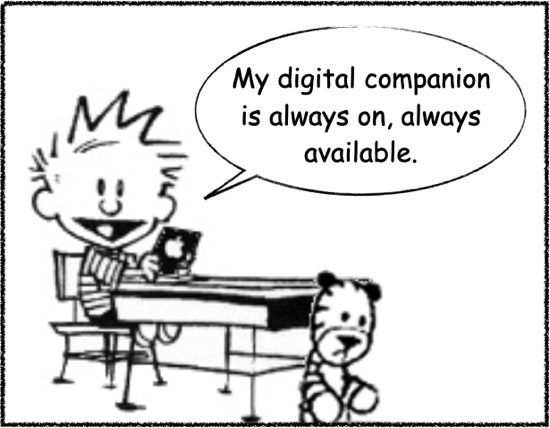«Every now and then I go into my own little world but its ok … they know me there»
Joel Hodgeson
A while ago, I read a scientific article by Klausen and Passman (2007) about pretend companions. The term «pretend companion» is used to as a «collective term that encompasses both entirely fanciful constructions (referred to here as imaginary companions) and ones in which physical objects are imbued with personality characteristics (personified objects)».
For the first, think Donnie Darko (although he wasn’t a child), for the later, think Calvin and Hobbes.
Apparently, 65% of all childhoods have pretend companions (imaginary friends/playmates, citing another study). One thing that struck me was that a study in India found few children with pretend companions, with the likely explanation put forth that children in India have limited playtime and limited time being alone.
Research in India on pretend companions suggests another reason why few reports of pretend companions have survived from previous centuries. Mills (2003) reported that there is no recognition of the concept of pretend companions in India. Even when allowing for the belief that some children have interactive memories of past lives, the prevalence of pretend companions was calculated to be only 0.2% (Barker & Pasricha, 1979). Mills ascribed the scarcity to the fact that Indian children live within a culture with limited playtime and little time for being left alone, conditions that could reflect the era before childhood was seen as a period for play and exploration. That is, because interacting with pretend companions is primarily (although not exclusively) a solitary experience (Taylor, 1999), children in India have had few opportunities to develop pretend companions. Further support for the notion that premodern societies did not foster pretend companions can be inferred from Mead’s (1975) observations in 1930s New Guinea, where there was also no childhood imaginative play. If pretend companions are indeed a modern phenomenon, then their genesis may result from being left alone and from having time available for play, customs that apply to contemporary Western children but rarely to children historically (deMause, 1974).
Klausen and Passman (2007), my emphasis
Given that the Klausen and Passman article was from 2007, the year when the first iPhone came out, and it was in 2010 when the first iPad became available, I wonder — what happened to children all over the world with these devices?
After all, with a digital device, you are never really alone. You always have distraction. If not other people, then digital games, perhaps even with NPCs that react to you. Who needs a pretend companion when there is a digital companion?

Scary thought, considering the role of fantasy, and enduring boredom, has in creativity.
Source: Klausen, E., & Passman, R. H., (2006) Pretend Companions (Imaginary Playmates): The Emergence of a Field, The Journal of Genetic Psychology, 167(4), 349-364, DOI: 10.3200/GNTP.167.4.349-364